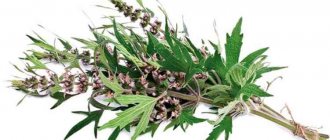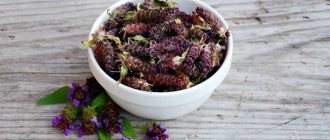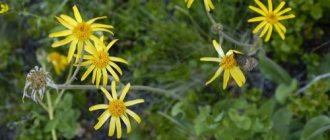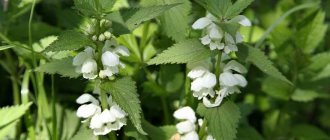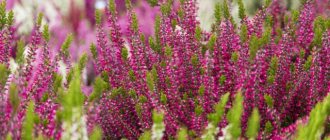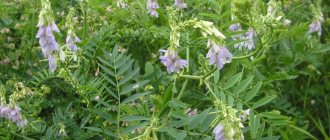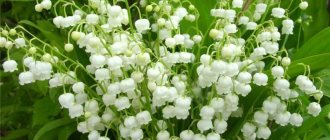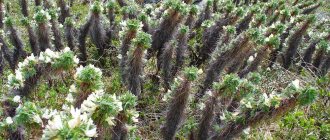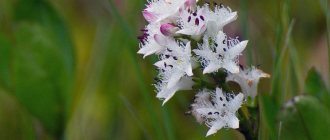What does orchis look like and where does it grow?
The name of the plant is due to its characteristics. Orchis is translated from ancient Greek as “testicle”. Indeed, the shape of the rhizome resembles a food product. However, there are varieties whose roots are more elongated.
Important! Orchis reproduces in two ways: self-seeding and root division.
The plant is called:
- orchis;
- the tears of a cuckoo;
- forest orchid;
- core;
- dog tongues.
The plant is distributed mainly in the Northern Hemisphere. This is due to the fact that orchis does not tolerate dry and hot weather, preferring subtropical, cold and temperate climates and moist soil. The forest orchid grows almost throughout the entire territory of Russia.
Often the core can be found in the Caucasus mountains and Crimea
Collection, preparation and storage of orchis
In folk medicine, daughter (young) orchis tubers are used, which are collected at the end or in the last days of flowering. The roots dug out of the soil are cleaned of dirt and thoroughly rinsed with running water. Experienced people recommend immersing the roots in boiling water for a short time to facilitate drying and prevent possible eye sprouting.
Ready-to-eat raw materials are divided into two types - heavy flattened egg-shaped tubers with saleps and powder with saleps. When stored in dry cardboard boxes or cotton bags, the roots retain their properties for up to six years.
Orchis tubers are collected at the end or in the last days of flowering.
Orchis species
The medicinal plant comes in several varieties. Their use depends on the indications for use in various diseases.
Male
The species grows in Ukraine, the Caucasus and the Urals (western Russia). It can adapt to a variety of soil conditions in deciduous forests. A waterlogged and acidic environment is not suitable for male orchis.
The flowers form a raceme and are distinguished by a crimson color. The rhizomes of the plant are used for medicinal purposes. Substances obtained from forest orchids can be used for the following pathologies:
- diseases of the gastrointestinal tract;
- cystitis;
- infertility.
The products have analgesic and wound healing effects. They help improve immunity.
Male orchis blooms in May-June
Spotted
The rhizome has an elongated shape. The species is also called fingerroot. The plant can be found in the following areas:
- Russia;
- Belarus;
- Ukraine.
A special feature is the root, which consists of young and old tubers. The tall stem has 8 leaves that are covered with lilac spots. The light pink flowers are distinguished by their helmet shape. Orchis is used to treat diseases of the digestive system.
The spotted species blooms from May to June
Helmet-bearing
The classic look has 1 stem. The leaves are located below. The flowers are light pink in color. Orchis orchis has 2 developed tubers. The plant prefers calcium-rich and dry soil.
The variety of orchis capulata is found in the meadows and fields of the Caucasus
Tubers are used to make medicines. They are used for the following purposes:
- improving potency;
- therapy of diseases of the respiratory system;
- normalization of digestion.
Important! The powder from the rhizome can be used to make baked goods and soups.
Burnt
This is a rare species. The plant is called Neotinea burnt. This core grows in deciduous forests and prefers predominantly slightly alkaline soil in the following areas:
- Russia (European regions);
- Anatolia;
- Belarus;
- Ukraine;
- Mediterranean;
- Scandinavia.
The long stem is distinguished by the presence of a helmet-shaped inflorescence. A well-developed oval-shaped rhizome has 2 tubers.
Burnt orchis can be used in the following cases:
- epilepsy;
- poisoning;
- inflammatory processes of the digestive system.
The flowers of the burnt orchis plant are dark red in color.
This amazing orchis
Northern orchid is the name often given to the beautiful and healing orchis plant, which grows in our latitudes and enjoys almost mystical fame.
Our ancestors considered it a love potion, and to this day, treatment with orchis by some healers resembles a kind of magical ritual.
It is believed that orchis is often used by healers to prepare their potions.
What is the plant famous for: erotic flower and other forms
There are other, very apt folk names for different types of wonderful flowers, which in themselves can say a lot about it:
- lady's pen;
- jelly root;
- priest's eggs;
- male satyr;
- nucleoli;
- naked men;
- cuckoo tears;
- baby grass.
Orchis flowers are sometimes called "naked men"
If you take a closer look, this forest grass is indeed a smaller and slightly simplified copy of a luxurious potted orchid, which is very fashionable today. And upon an even closer look at orchis flowers, you notice that their “tongues” surprisingly resemble little men. It’s not for nothing that the plant is most often called “naked men” in England.
The entire orchid family, to which the genus Orchis belongs, derives its name from the word “orchis”; it is translated from ancient Greek as “testicle”. The word “yatro” was also translated from Old Slavic, which gave the orchis its Russian name. The amusing resemblance to the male genital organ made the plant a hero of love magic back in ancient times - among both European and Eastern healers. However, practice has confirmed that orchis really helps increase male strength and sexual desire.
Girls with bouquets of orchis flowers - in the old days such a meeting was common
The bright appearance and healing power of orchis played a cruel joke on him. It was so mercilessly exterminated by people for a very long time that the northern orchid in nature has become a rare, endangered phenomenon (especially in the southern regions) and is now listed in the Red Books of many European countries. The only hope for the revival of this small miracle may be the cultural cultivation of orchis - a difficult task, but noble and rewarding.
Similar to both a tulip and a hyacinth - and at the same time unlike anything else.
Leaves like a tulip, an elegant inflorescence reminiscent of a hyacinth, and an incomparable root - it is the orchis tubers that are precious medicinal raw materials. Each plant has at least two tubers: an old one and a young one. It is the young tuber, the source of the unique natural substance salep, that is used in medicine, both traditional and folk.
Salep was included in the pharmacopoeia of the USSR, but official medicine uses only the enveloping and expectorant properties of this plant, while orchis finds much wider use in folk healing.
Salep is also a delicious warming drink
By the way, salep is also a name for a thick hot drink, which is very popular in many eastern countries - for example, in Turkey. To prepare it, the powder from the orchis tuber is steamed with hot water or milk and seasoned with various spices. Salep is considered a remedy that repels diseases, attracts luck and strength - of course, primarily masculine.
Plant species
More than a hundred species of orchis are known in nature; not long ago, botanists divided them into two different genera of the orchid family. Despite some external differences, the healing properties of plants are similar, although in most species they have been studied little and have not yet received official confirmation.
Orchis blooms predominantly purple
More often than other types in folk medicine, the salep of the following orchis is used:
- spotted;
- male;
- female;
- Italian;
- purple;
- dremlika.
Photo gallery: such a different orchis
Male orchis grows in deciduous forests, prefers mountainous terrain
Burnt orchis - an endangered species listed in the Red Book
Spotted orchis is a very popular plant among the people; settles in meadows and forest clearings
Orchis orchis loves wet meadows and the bottoms of damp ravines
Orchis loose-flowered has wonderfully beautiful flowers
Italian orchis - the British call it the “naked man”
Orchis dremlik - beautiful and healing
Purple orchis grows and is used throughout Europe
Female orchis is used in folk recipes, usually together with male orchis.
Composition and benefits
The basis of the orchis tuber is made up of healing mucilages - sometimes there are more than half of them in salep. It also contains a lot of starchy substances - about a quarter of the total weight. In addition, salep contains other valuable, active natural substances:
- Sahara;
- resins;
- protein compounds;
- mineral salts;
- pentosan and methylpentosan;
- glycosides;
- dextrin;
- bitterness;
- essential oil.
Orchis tubers have a unique composition.
Healers widely use the unique capabilities of orchis not only to improve the quality of sexual life of their patients, but also in many other therapeutic areas. Salep has a beneficial effect on the entire digestive system. It helps well with poisoning and various disorders in the gastrointestinal tract, restores the body's defenses and reserves.
Salep has a beneficial effect on the gastrointestinal tract
In some Eastern countries, ancient traditions of eating orchis tubers are preserved. Various sweet dishes are prepared from them: jelly, jelly, baked goods, and even soups. This is not only delicious, but also a very healthy menu.
The wide range of healing abilities of orchis includes many diseases - in serious cases it can be considered, of course, only as an adjuvant to general drug therapy. But even taking this into account, the list of ailments that retreat before the power of salep is quite extensive:
- cystitis and inflammation of the genitourinary area;
- gastritis and peptic ulcer;
- impotence and infertility;
- prostatitis;
- diarrhea and colitis;
- dysentery;
- bronchitis;
- tuberculosis;
- paralysis and convulsions.
This pretty flower is the enemy of serious illnesses
It is curious that salep, which is a recognized remedy for the treatment of infertility, both male and female, in some regions is still used with equal success as a contraceptive or abortifacient.
How to save
A young orchis tuber, also called salep, is considered fully formed at the beginning of summer - at the moment when flowering ends. During this period, it is at the peak of its usefulness, but you need to have time to dig it up before the flower arrow withers.
Orchis leaves and flowers are used less frequently than its root
Remember that no benefit of orchis can justify its destruction in nature. Do not dig up a unique plant in its natural habitat. In the fall, collect boxes with ripened seeds and sow orchis in your summer cottage - in nature, it mainly reproduces by seeds and, with proper care, takes root well in new territories.
Excavated salep requires certain processing before storage. You need to wipe it from any remaining soil, rinse it and remove the outer skin. Then the tuber is immersed in very hot (but not boiling) water for a few seconds. This procedure is necessary to ensure that the tuber does not subsequently germinate; in addition, after scalding it will be easier to grind the salep.
Salep - precious medicinal raw materials
The processed salep is dried - hung in a well-ventilated place, where moisture and rays of the sun do not reach. Powder for medicines is prepared from well-dried raw materials. If all necessary conditions are met, it can be stored for a long time - up to six years it does not lose its beneficial properties. You can prepare healing potions from a freshly dug tuber.
The tubers that are round in shape are considered the most valuable in terms of medicinal power, but oblong (finger) specimens can also be used in folk medicine.
There may be a clearing with orchis at your dacha.
Grass and, moreover, orchis flowers are used much less frequently for medicinal purposes. They are harvested at the same time as the tubers and dried in any convenient way. Such raw materials are usually stored in glass, tightly closed containers for no longer than two years. Some herbalists also use orchis seeds according to personal methods - they prepare decoctions for patients with epilepsy to reduce the frequency and severity of attacks.
Properly dried tubers acquire extraordinary, almost stone hardness. It's difficult to grind them. Before grinding dry salep, crush it with a hammer into the smallest pieces possible.
Salep powder is a very useful preparation for the winter.
Video: healing capabilities of orchis
What are the benefits of orchis?
In folk medicine, forest orchid is valued for its beneficial effects on the body. The core has the following beneficial properties:
- hemostatic (blood purifying and hematopoietic);
- enveloping;
- anti-inflammatory;
- strengthening.
Medicinal properties of orchis for men
The plant is effective in cases of reproductive dysfunction. The healing properties of orchis for men are used to increase potency.
Forest orchid is recommended for inflammation of the prostate gland
The healing properties of orchis for women
The root is used to make contraceptive infusions. Remedies from the core help restore the cycle.
Decoctions based on dog tongues strengthen hair and give it a well-groomed appearance.
Application in medicine
Plant-based remedies are used to treat many different diseases. Orchis has an enveloping, astringent, antiseptic, immunostimulating effect on the body, and promotes the removal of toxins and waste.
The tubers of the plant are used to prepare oral medications and medicinal enemas. An aqueous infusion of orchis has a blood purifying, anti-inflammatory, restorative, and immunostimulating effect on the body.
Indications for the use of orchis-based products in folk medicine are the following pathological conditions of the body:
- enteritis
- haemorrhoids
- gastritis
- colitis
- bronchitis
- tuberculosis
- nervous exhaustion
- intoxication of the body
- peptic ulcer
- inflammatory diseases of the oral cavity (stomatitis, gingivitis)
- diarrhea of various etiologies
- prostatitis
- gynecological diseases
But most often, orchis is used to increase libido and potency in men. This plant is a strong aphrodisiac and helps with erectile dysfunction and decreased libido.
Orchis decoctions and tinctures effectively eliminate not only somatic, but also psychological causes of impotence.
- increases libido and sexual stamina
- relieves anxiety, fear of failure
- increases the tone of the reproductive system organs
- increases fertility
- relieves nervous tension, chronic stress, overwork, gives strength, increases vitality
- prevents the development of hemorrhoids and urological diseases
What does orchis treat and what does orchis help with?
Products based on forest orchid can be taken to treat and prevent various diseases. Orchis can be brewed for the following pathologies:
- sexual dysfunction (in women and men);
- tuberculosis;
- enteritis;
- poisoning;
- gastritis;
- ulcer;
- nervous disorders;
- diarrhea.
Important! Before using orchis based products, contraindications should be excluded.
Infusion
Forest orchid can be used to relieve diarrhea. Add 120 g of dried root (salep) to 500 ml of boiled hot water. The product is infused for half an hour.
An infusion of forest orchid root is recommended to drink a teaspoon every hour until the unpleasant symptoms disappear.
In case of poisoning, add 1 teaspoon of orchis powder to 200 ml of boiled hot water. The product is infused for 50 minutes, honey is added. The resulting drink is taken twice a day.
Tinctures
Fresh orchis root and rye bread should be crumbled. Cognac alcohol is poured into the mixture and the product is placed in a dark place. After 2 months, the infusion is squeezed out. The cake is burned and added to the liquid. They insist for another 2 months. Before use, the product is mixed with red wine.
It is known that orchis flowers are used as medicines quite rarely. For inflammation of the prostate gland, you can make and take tinctures from olive oil.
The flowers must first be dried and crushed. Raw materials (50 g) are poured with olive oil (500 ml). The composition is kept for 2 weeks in a dark and dry place. Before use, strain the tincture. The product is taken twice a day before meals, 2 tablespoons.
Orchis tincture is intended to strengthen the immune system
Decoctions
For hemorrhoids, 10 g of root powder is poured with milk (200 ml). The mixture is boiled for 10 minutes, cooled. You need to drink a decoction of orchis in equal portions.
For hemorrhoids, take a remedy from the roots every 2 hours
Decoctions are used for prostatitis. Add 2 teaspoons of orchis root powder to 250 ml of water. The composition is simmered over low heat for 10 minutes. The product is cooled and filtered. Drink the decoction three times a day, 3 tablespoons.
Ointments
For abscesses, dog tongues can be used externally. Pork fat and root powder are mixed in equal proportions in a container. The mixture is applied to the affected area. After treatment with ointment, the abscess site is bandaged.
The root is used to make products for external use.
Kiseli
Orchis helps restore the menstrual cycle. To prepare jelly, fresh root is crushed and poured into a glass of milk. The mixture is shaken until a thick consistency is obtained, filtered, and red wine is added.
Salep root jelly can be taken before sexual intercourse
To treat and prevent colds, mix rhizome powder, starch (25 g each) and sugar (100 g). Then add water until the consistency of sour cream and 250 ml of milk are obtained. Boil the mixture for 5 minutes, cool, add cinnamon for taste. Kissel is drunk in small sips.
General information
Description of orchis
This perennial is a member of the Orchid family. The stems of orchis are straight and their height depends on the species; generally it grows no higher than 70 cm. The narrow leaves are dark green, some varieties have purple spots on them.
With the onset of April, the plant produces spike-shaped inflorescences with many small cherry-colored buds. Flowering lasts 1.5 weeks and is accompanied by a honey aroma. As the flowers wilt, seed pods form.
The root of the orchis is tuberous; it is this part that is most often used by traditional healers.
Orchis grows in the northern part of the hemisphere with a temperate or subtropical climate. It mainly grows in sunny meadows and forest edges, sometimes in slightly shaded areas. Varieties of orchis prefer different soil compositions, but none of them like light and moisture-loving plant neighbors.
Interesting! It is difficult to find a large clearing with orchis; it usually grows in single specimens. Due to its widespread use and collection of wild plantings, the plant is included in the Red Book.
Plant composition
Each part of the plant has a different composition. Shoots and leaves are rich in glycosides, carotene, bitterness and pectins. Orchis roots consist of the following chemicals: pectin, sucrose, bitterness, mucus, starch, essential oils.
Areas of application of orchis and medicinal properties
The properties of orchis are valued for their versatility. The plant can be useful not only for men, but also for women with children. The presence of mucus in the roots gives orchis enveloping properties, which helps protect the body from toxins that enter the bloodstream from the stomach. The inside of the orchis root is called salep and it is a component of useful enemas and preparations.
An infusion of the roots can cleanse the blood, the body as a whole, and have an anti-inflammatory and hematopoietic effect.
If we talk about diseases, a remedy based on orchis helps treat:
- inflamed hemorrhoids with bleeding;
- gastritis and peptic ulcer in the acute stage;
- diarrhea and stomach upset;
- prolonged bronchitis;
- poisoning by poisons or toxins;
- diseases of the genitourinary system in men and women.
Root tubers of some varieties are used in cooking, and some are grown as ornamental plants.
Interesting! Orchis root mucilage is used in enemas and to treat stomach inflammation. It also cures cough and inflammation of the mouth well.
Orchis is an effective tonic and strengthening agent that helps get rid of weakness after a protracted illness, reduce nervous exhaustion, and also increase sexual strength.
It is not possible to identify specific contraindications to the use of orchis. Its use is rarely accompanied by side effects, and in most cases they are associated with the personal reaction of the body.
Contraindications
Orchis grass is called a special plant. This is due not only to the fact that the forest orchid is listed in the Red Book. Orchis can be both beneficial and harmful.
We recommend reading: Kupena officinalis: description, use in medicine, photo
The core is well tolerated and rarely causes allergic reactions. Water and milk products made from orchis can be drunk even by children and pregnant women. However, before using decoctions or infusions, it is advisable to consult a specialist.
You should not combine the use of dog tongues with medications containing tannin. This can lead to dysfunction of the digestive system.
Contraindications and side effects
Medicines containing orchis extract have no contraindications. They are allowed to be taken by young children, pregnant women and nursing mothers after consultation with their doctor.
Men using herbal teas and infusions to stimulate the reproductive system must strictly adhere to the prescribed dosages. Excessive consumption of the herbal root or ingestion of aerial parts of the plant may cause undesirable effects such as:
- disorders of the gastrointestinal tract
- disturbance of gastric microflora
- pain syndrome
- nausea and vomiting
Collection and preparation of grass
The orchis, the photo of which is located above, is listed in the plant register of the Red Book. Collection is prohibited in the natural environment. Harvesting for medicinal purposes is carried out if the forest orchid is grown independently in a summer cottage.
Flowers are harvested during April-June. During this period, abundant flowering is observed. The tubers are collected later.
Attention! To obtain powder from the roots or salep, young tubers are used. They have a yellowish tint.
It is noteworthy that the leaves and stems are not used for medicinal purposes. They do not have beneficial properties and can cause digestive upset.
It is important not only to take orchis correctly. Compliance with the rules for its storage is essential. Raw materials are kept in a dry and ventilated place. In this case, the healing qualities are maintained for 6 years.
Beneficial properties of orchis
Since ancient times, people have known about the beneficial properties of orchis and used preparations based on it to treat various diseases: herpes, ulcers, inflammation and diarrhea. The valuable medicinal raw materials of this plant are the young tubers, otherwise called “salep tubers.” They are collected at the end of orchis flowering from July to August.
According to their shape, there are 2 types of tubers: round - 1-1.5 cm thick (they are considered the best) and palm - 0.5-1 cm thick. It is recommended to store the collected raw materials (tubers) in tin cans and in a dark, dry room, since When exposed to moisture and light, the finished product turns black and very quickly loses its healing properties.
Tubers contain about 50% mucus, 27% starch, about 5% proteins, calcium oxalate, mineral salts, sugars, and a small amount of resins.
Benefits of orchis flowers and roots
Despite the fact that the aerial part of the plant has an antibacterial effect, orchis flowers and leaves are rarely used for treatment and mainly as an external remedy.
Orchis is used in many folk recipes.
But there is a recipe for an infusion of powdered dried orchis flowers in olive oil in a proportion of 50 g per 0.5 l. After infusion for 14 days in the dark and at room temperature, the infusion is filtered and taken for prostatitis 2 times a day, a spoonful before meals.
Orchis: description and composition
Orchids belong to the numerous genus of the same name in the orchid family. The range of orchis is wide; they can be found in different countries of the northern hemisphere, where the climate is subtropical or temperate. For their habitat, northern orchids choose sunny or slightly shaded places: forest edges or meadows. Each species has its own requirements for soil moisture, acidity and nutrient supply. These plants are united in one thing - they do not like competitors in the neighborhood for moisture, light and nutrition.
Since ancient times, people have known about the beneficial properties of orchis.
Orchis usually grow in single specimens. It is very rare to find several plants at once in one place. Due to their uncontrolled extermination during collection for the preparation of medicines and the reduction of possible habitat areas, the number of orchises is rapidly declining, and most species are already included in the Red Book.
Minoxidil 2% - https://minoxidil5.ru/dlya-volos/minoksidil-2-zhenskij/, the drug is designed for the treatment of alopecia in women at home.
Biological features:
- Orchis is a herbaceous perennial.
- Its roots are thin and underdeveloped; the plant has a tuber - salep, which is replaced annually. During the growing season, orchis has two of them - old and young.
- The stem of the plant is erect and can reach a height of 15 cm, depending on the species and its habitat.
- The leaves are lanceolate or broad in shape. Tightly grasping the stem, they narrow, forming a thin petiole.
- Each species has its own flowering time. In spring, the orchis develops a long, non-leafy stem bearing a spike-shaped inflorescence up to 15 cm long with numerous small flowers.
- The color of the flowers depends on the species and can be white, crimson, cherry, lilac-pink. But the shape of the flower is the same for all species: the upper petals form a kind of helmet, while the lower petal, divided into 3-5 lobes, is a lip decorated with a spur.
Due to the peculiarities of their biological structure, orchises tolerate unfavorable conditions well - the accumulated substances in the tubers allow them to live in cramped circumstances even for several years. The brightly colored flowers have a faint aroma, dominated by vanilla and honey. Interestingly, a flower can live on a plant for up to 10 days until pollination occurs. After this, it immediately fades.
In the vast majority of orchises, reproduction is by seed. Some species have a vegetative method of propagation - instead of one replacement tuber, the plants grow a pair.
The chemical composition of the plant has been studied quite well. Its main components:
- sucrose and polysaccharides;
- bitterness;
- minerals;
- starch and dextrin;
- pentosan and methylpentosan;
- resins;
- protein;
- mucus;
- pectin substances.
Orchis juice.
Orchis juice extract of roots, leaves and flowers.
Orchis is used as an aphrodisiac and restorative tonic. Medicinal properties:
Orchis tubers contain potassium and calcium minerals, bitterness, essential oil and active alkaloids, which give the extract its main medicinal properties.
Key therapeutic benefits:
As an aphrodisiac, orchis is useful in the treatment of male sexual disorders such as erectile dysfunction and impotence. It is a sedative and treats stress and mental disorders.
Orchis helps solve problems such as premature ejaculation and sexual weakness.
Application of bee propolis:
Orchis extract is truly a relief for patients with sexual dysfunctions. It improves libido, increases ejaculation time and enhances sexual pleasure!
Infertility treatment
For disorders of the genitourinary system, reproductive function, infertility (male, female), it is recommended to take a decoction of orchis tubers and knotweed herb. The treatment is long-term – at least six months without breaks. Preparation:
- Mix orchis powder (15 g.), chopped knotweed grass (10 g.) chopped into small pieces. If dry vegetable raw materials are used, reduce the amount by half.
- Pour boiling water (150 ml) over the herbal ingredients and wait a quarter of an hour.
- Leave the product to simmer in a steam bath, remove after 10 minutes.
Article for you:
Medicinal and beneficial properties of Pallas's milkweed and its use in traditional medicine
Strain and drink instead of morning tea or coffee in one sitting. Do not use the product again during the day. The first days of taking the decoction can cause unpleasant reactions - mild nausea, a slight increase in heart rate, short-term diarrhea.
If such symptoms occur, it is recommended to reduce the amount of herbal components and take a less saturated product for a week.
After the disappearance of unpleasant signs, gradually increase the amount of herbs to reach the desired volume.

